The life and times of Ed DePriest were mysterious for a number of years.
When we started looking for him a decade ago, some thought he was dead, whilst others told us his name was a pseudonym. All of which is ironic because Ed never left the adult film industry.
The truth is that Ed is alive and well, but for the last 50 years he has preferred to stay in the shadows. “It’s not about the person; it’s about the product”, he told us when we finally contacted him.
But what a life… He started out making surfing movies in the early 1960s, before making underground experimental films and then joining the sexploitation wave of the 1960s, turning to hardcore films in the 1970s, and adapting quickly to making adult videos in the 1980s.
Along the way he crossed paths with Ed Wood, Dave Friedman and Dan Sonney, Gary Graver (aka Robert McCallum), Desiree Cousteau, Annette Haven, Manuel Conde, Bob Chinn, Johnny Legend, Yoko Ono, Linda Wong… and Harrison Ford?
So why is Ed DePriest telling his story now? What has changed his mind?
“The rumors of my demise have been highly exaggerated, so you better get me while I’m still around. I was always just happy to do business through my companies, but I figured at the end I might as well come clean”, he says.
Finally the time is right.
The Rialto Report’s Ashley West assembled an interview team of Joe Blevins (from the website Dead 2 Rights, which has an excellent series of articles about the career of Ed Wood), and Vinegar Syndrome’s Joe Rubin, to join him in a rare interview of Ed DePriest. Here’s what we learnt.
Thanks to Ed De Priest for many of the rare images used in this piece.
If you worked with Ed De Priest, please get in touch – we’d love to hear your memories. (Especially if you are Pat Barrington or Antoinette Maynard!)
_______________________________________________________________________________________________
You’ve been in the film industry for over 50 years, but you’ve been so elusive as your name appears on very little of what you were involved in. Did you ever keep a record of all the films you worked on?
Nah, I didn’t keep any records. I was just trying to earn a living. Basically, I started off as a cameraman and then became a director/producer. But mainly I consider myself as someone who has had different companies; that’s basically what I’ve done all these years.
I had Dyle IV Films, then Canyon films, and then I had Vista Video in the early video days, then Mirage Video, and then Dakine Media. Most recently I formed Golden Age Media.
I’ve been buying and selling, producing, directing and trading movies for 30 or 40 years – but yeah, nobody knows. They don’t know me because what’s out in the public are the companies, not my name.
I always like the company to lead the way. It’s about the product, not about me.
Ed DePriest – The Surfing Years:
What films did you grow up on?
I’m a film guy. I’ve always loved films from when I was a little kid going to the RKO Studios. I used to collect the lobby stills. I grew up in Encino, and I used to go and walk by Roy Rogers’ house where he had Trigger. That was where all the movie stars lived in the early 1950s – in Encino.
I liked the cowboy movies when I was young. There was a movie theatre called The Hitching Post in Santa Monica and I would go there. I liked Laurel and Hardy and the East Side Kids and stuff like that.
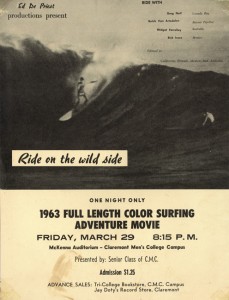 What were you doing in the early 1960s after you left school?
What were you doing in the early 1960s after you left school?
Before I started filming I was making surfboards. The guy I was working for, Greg Noll, was a filmmaker, so I was interested in that. He taught me how to use a 16mm Bolex and I think he also had a Bell & Howell. While I was making surfboards I earned enough money to buy my own camera equipment and I went to Hawaii and made my first surfing film, ‘Ride on the Wild Side’ (1963). I showed it at the Santa Monica Civic Auditorium, and in various high schools. Mostly in California.
Can you remember how much you spent on ‘Ride on the Wild Side’ (1963)?
Not really. I remember that I went to Eastman Kodak on Santa Monica Boulevard to buy the film stock and they had just come out with Ektachrome. Before that it was Kodachrome, and 16mm Kodachrome had very hard and bright colors; the colors were blue and red and green and they were very prominent. But when they came out with the Ektachrome it was kind of pastel colors. It looked like Technicolor, which was gorgeous.
I went there to buy the film stock, and I remember that they gave me some special jells I had to put on the camera to shoot outdoors. The film came out beautiful, it was absolutely gorgeous, and later I sold it to Paramount.
What did Paramount do with it?
They released a two reel 35mm version of it which won a couple of awards, in Washington DC and the Cortina Film Festival in Italy in 1966. I was pretty happy with that.
It was at this time that you met Don Brown, who much later became the adult film director Bob Vosse.
Yeah, Don Brown was a guy I knew from the surfing days. Maybe Greg Noll hooked me up with him.
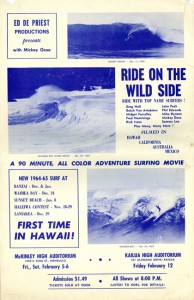 Don was a jack-of-all-trades. I met him originally because somehow I found out he was making motors for Bolexes. I remember when I first met him he made me a motor for my Bolex. In those days, the Bolex had a hand crank and he made me a motor that I took to Makaha in Hawaii when the surf was big, and I used this motor that I had bought from him.
Don was a jack-of-all-trades. I met him originally because somehow I found out he was making motors for Bolexes. I remember when I first met him he made me a motor for my Bolex. In those days, the Bolex had a hand crank and he made me a motor that I took to Makaha in Hawaii when the surf was big, and I used this motor that I had bought from him.
He did a bunch of surfarama things at the Santa Monica Civic Auditorium in the early 1960s. He made a 35mm feature with some of our footage called ‘Surfari’ that ran in the regular theatres.
Then later he changed his name to Bob Vosse and he made a bunch of X-rated movies. Some of them were pretty good like ‘The Best Little Whorehouse in Hong Kong’ (1987) and ‘Sex Life of a Porn Star’ (1986). He had a sound stage in San Francisco.
You hadn’t edited a film before – I’m assuming you cut the film yourself – so how did you learn the process? Did you just cut the original and not do any work print?
Yeah. I cut the original on a moviescope and spliced it and then went and made a print. When I would do my 16mm features, I had a moviescope with a splicer and a splice box and reels, and then I went down to Hollywood and made a print at one of the labs. Then when I would show the print, I would stand up and narrate it in person.
You never created a soundtrack for it?
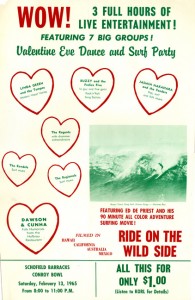 I did later on, but when I started out in 1963, you would stand up on the stage with a microphone and a tape recorder, and you would narrate the film to the audience.
I did later on, but when I started out in 1963, you would stand up on the stage with a microphone and a tape recorder, and you would narrate the film to the audience.
What do you remember about the music in these films?
In the first surfing films they used groups like The Ventures and tracks like Green Onions. The surf photographers would just take the music that they liked. Dick Dale came along later, maybe four or five years after those first surf films came out.
I saw some of the handbills for your movies; there were often these live bands playing at them. Did you have bands playing live at your show?
Yeah, a couple in Hawaii we did.
Did you like the filmmaking straight away?
I had a good time making the film and editing it, but I was not a good businessman. I wasn’t like Bruce Brown, who had made the surfing film ‘The Endless Summer’ (1966); he was very organized and he had a system where he would go all over the country and that was a little beyond my abilities at that time.
What do you remember about other surfing movies you made, such as your work with Walt Phillips on ‘The Waves’ and ‘Pipeline’?
We didn’t make that many. I wasn’t in the surfing movie thing that long, maybe four years. It kind of petered out for me because I wasn’t a very good businessman so I had to make money in another way.
So I got this job as a grip on that ‘She Freak’ (1967) and then from there, I went on to the nudie stuff.
Ed DePriest – Introduction to Sexploitation:
How did you first come into contact with sexploitation films?
I had a friend, Bill Marky, who was a soundman and he worked at Warner Brothers on feature films and TV shows. He lived in Malibu and I would stop by his house when I’d go up to surf there.
He got me a job as a grip on a film called ‘She Freak’. Dave Friedman was producing it in Bakersfield where there’s a kind of a carnival little circus thing.
That was how I got to meet Dave Friedman, Peter Perry, Dan Sonney and Seymour Borde who were all down on Film Row, and that’s where I got my first view of these nudie-cuties.
What were these guys like?
Dave Friedman and Sonney were really great guys. I was fascinated by these old film guys who kind of flew by the seat of their pants and traveled all over the country, renting these main street cinemas and showing these exploitation films. I just thought they were the greatest.
Dan Sonney was as real character; here was a guy that traveled the country with these ‘mom and pop’ shows where they would come in with a doctor and nurses, and they had these shows where they’d show the birth of a baby.
The men would have to be in the balcony and the women would be downstairs.
The guys of Film Row even had a mummy that Dan Sonney’s father, Louis Sonney, had had in a freak show and Dan kept it back in the room where all the prints were. I would have to go back there to get some editing equipment and there was this mummy just sat in the corner.
I remember I was in there once, and Peter Perry closed the door and locked the door behind me. He put a bunch of big film cans by the door and said you’re going to stay in there with the mummy. He thought that was funny as hell, but it kind of creeped me out!
How did you get to know Peter Perry?
He made movies for Dan Sonney. He was a real film guy. He knew how to make movies; he knew how to edit them, how to hire the cameramen to run out and shoot scenes, everything.
He was the one that taught me how to edit and stuff. I had edited some films myself by then but that wasn’t really with sound or with 35mm, and it wasn’t really editing where you would build a soundtrack and the effects tracks and do everything on the moviola. Peter was the one that taught me how to do that, he was a real good technician. A nice guy too.
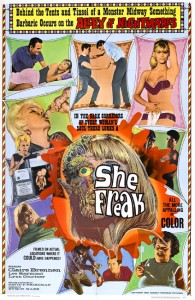 ‘She Freak’ (1967) was directed by Byron Mabe. Do you have many memories of him?
‘She Freak’ (1967) was directed by Byron Mabe. Do you have many memories of him?
I didn’t get to spend much time with him. I was just a lowly grip on that production so I didn’t really know anything about him. Byron had his hands full directing and he seemed a little nervous.
Do you remember Dave Friedman on the set?
Dave was very friendly with me; he was the producer and the soundman on the film. His girlfriend was the girl, the blonde in the leading role; I remember Dave having a little fling with her.
I guess that once you met guys like Dave Friedman and Dan Sonney for the first time, you thought “I can actually make money in this kind of film” because these were guys who had shown you how to do it?
Absolutely. With the surfing thing I really couldn’t make any money. After meeting these guys I went out and made a nudie cutie film right away with Walt Phillips. We got some girls and made them take their clothes off, and did some scenes and made a little movie. Walt had a Porsche so we picked these girls up and we made a little movie. I don’t remember what the script’s story was or what happened to the film, and I don’t even remember the name of it.
We showed it to Dave Friedman, but it wasn’t long enough to blow up to a 35mm feature, so we went and found another way to sell it. Eventually we did sell it to some theaters that were showing 16mm, the Vista and then the Paris.
Paul Hunt, Mike Weldon and the underground films:
When did you become friends with Mike Weldon?
I actually knew Mike the longest. We were neighbors when we were kids, and he and I went to junior high school together in Manhattan Beach.
We were both surfers, and we both had Whizzer motorbikes. When my Whizzer would break down I would go to his garage and see if he had a spare magneto or whatever. So I was always at his house because those little Whizzer motorbikes were notoriously breaking down all the time.
When I started making surfing films, Mike started helping me on the exhibition side, and particularly helped me with some of the distribution stuff.
What was Cinema 16?
That came about when I was doing my surfing films in about 1965.
Mike and I formed our first company, Cinema 16, which was a little 16mm theater in Hermosa Beach next to the Winchell’s Donuts where all the kids would come at night to get a donut or an ice cream. We had a little storefront next door to that, and we opened it up and had 25 seats in there. We had a 16mm projector.
What films would you show?
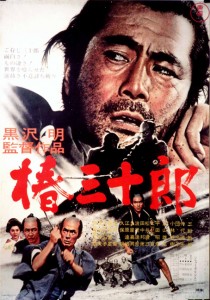 During that period I went to a lot of foreign movies as I was really into the black and white films. When I lived in Hawaii, I started seeing these Japanese films and Samurai films and really loved them. Back in California, I was taking karate lessons from Hidetaka Nishiyama who was a famous instructor from Japan, and I went to see this movie called ‘Sanjuro’ (1962) with Toshiro Mifune, and was just blown away.
During that period I went to a lot of foreign movies as I was really into the black and white films. When I lived in Hawaii, I started seeing these Japanese films and Samurai films and really loved them. Back in California, I was taking karate lessons from Hidetaka Nishiyama who was a famous instructor from Japan, and I went to see this movie called ‘Sanjuro’ (1962) with Toshiro Mifune, and was just blown away.
Anyway, across the street was this distribution company, Tahoe International, so I went in there and talked to this Japanese man and asked them for a 16mm print of ‘Sanjuro’. I told them I was opening up dojos for Nishiyama and I would like to use a print to promote Japanese culture. They gave me a 16mm print and a bunch of fliers and posters for a month, and that’s how we opened up Cinema 16. So we started by playing Japanese films at the Cinema 16, and then we got early art films from a place in Hollywood.
How long did you have that place for?
We had that for, I think only the summer, maybe for five or six months, and that was it.
When did you meet Paul Hunt, who would go on to become your partner?
I met Paul Hunt probably in 1966 at Birns & Sawyer; that’s a camera rental place in Hollywood where people would rent film equipment. We immediately became friends.
What was he like, and what was his talent in terms of the filmmaking process?
He was a good hustler. He was at the other end of the spectrum that I didn’t have, I’m a little bit of a recluse, and he was personable. He went out and raised money for projects, he was very ambitious. I guess I was too, but I don’t think I was as pushy as he was.
How did you and Paul Hunt make money in the early days?
We did a lot of underground films. There was a place called a Cinematheque, which was just off Sunset Boulevard, actually in an alley off Sunset Boulevard near the Sunset Strip. They showed ‘Scorpio Rising’ (1963) and different underground movies. Lewis Teague ran the Cinema 16. He later became a film director and made big Hollywood films like ‘The Jewel of the Nile’ (1985) with Michael Douglas.
Anyway, we decided to make underground movies. We kind of made fake underground movies and had an underground distribution. We would put them together into a program with other shorts, to make a two hour or three hour reel. That was when Warhol was doing ‘Sleep’ (1963) and ‘Empire’ (1964) and all those movies.
I met Yoko Ono and got her short ‘A Walk to the Taj Mahal’ (1964). It was a 12 minute film that was in black and white that showed butts walking away, that is nude butts, the camera was very close up on the person’s butt and it dollied with the person as the person walked away. It would capture one butt to the next, and after watching all these butts they would have personalities, they were like smiling at you. There was some music track too, but I don’t remember what it was.
We’d send this reel with the shorts to the Uptown Theater in San Francisco and different theaters around the country. These underground movies did big business for about a year and a half. It was a little fad for a while and we made good money.
Were your films avant-garde in terms of the aesthetic?
Not really. We did a kind of a cheesy version of that. We went out and shot stuff and made it look underground. We were really trying to make product. By that time we had an office and people who worked for us and cameramen and stuff, so we had to come up with product that we could start sending out and earning money.
So they weren’t shown as secondary features?
No – this was the whole bill; it consisted of a collection of shorts.
An experimental film that you made around the time was ‘The Psychedelics’ (1966). Was this a feature film?
No, it was a 35mm short with Pat Barrington. It was only 20 minutes long.
I was playing it at the Cinematheque, and it got a lot of word of mouth in town. Everybody liked it because we used this really neat trick to put these images on Pat Barrington’s body as she was doing a belly dance.
It was just perfect, and it was an the height of the LSD period and all the hippies loved it.
Didn’t you have a problem with music you used in that film?
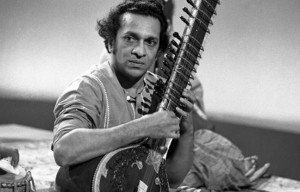 Yes, I used Ravi Shankar music.
Yes, I used Ravi Shankar music.
One day Ravi came down to the office and said, “Hey, I hear you’re using my music!” and he wanted to see the movie. He came down with all his entourage from World Pacific Records to our office on Melrose. They wanted to see the movie, so we cranked up the 35mm projector and he sat there with his people.
He liked the movie, and wanted to get a print of it but he said that we had to take his music off. Anyway he didn’t do anything, he was very pleasant.
Dyle IV Films:
How did Dyle IV Films come about?
Paul Hunt and I formed and owned Dyle IV Films, we owned it 50/50. We wanted to learn the mechanics of filmmaking, how to check the F stop, how to load the camera, how to load a magazine, how to unload it, how to go to the lab, how to edit it. We want to learn everything about filmmaking and that’s an expensive undertaking. So we formed Dyle IV Films to make nudie films so we could continue learning how to make films because we were so in love with the movies. And we made some good 35mm features.
How would you and Paul divide up the work?
He went out and got the financing and I oversaw the making of the movies. He helped me, he did the sound, but I basically made the movies. He got the money and then I distributed them, whilst he ran out and got more money.
How many movies did you make with Dyle IV Films?
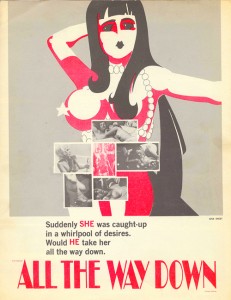 I think there were four movies but I can’t remember well which ones they were. I think they were ‘Jefferson Hotel’, ‘All The Way Down’, ‘Blow the Man Down’ and ‘The Gay Life’.
I think there were four movies but I can’t remember well which ones they were. I think they were ‘Jefferson Hotel’, ‘All The Way Down’, ‘Blow the Man Down’ and ‘The Gay Life’.
Didn’t Mike Weldon come on board and work for Dyle IV as well?
Mike Weldon was our salesman. Mike was the guy who was booking all the stuff in the theatres. He was a good salesman too. He was a real talker and he would never give up, in fact he was the one who put our films in the Uptown Theater in San Francisco with a guy named Harold Greenland who owned a bunch off theaters throughout the western states.
We gave him 15%, and he ended up making more money than we were because he got 15% off the top.
What do you remember about one of your first films, ‘All The Way Down’ (1966)?
We made ‘All The Way Down’ in black and white for $3,700 and I cut the negative. It was a 75 minute black and white feature in 35mm, with an answer print, all made for just $3,700!
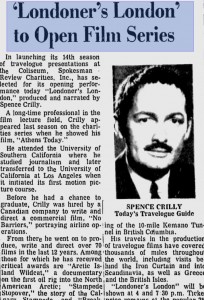 The director was Zoltan G. Spencer but his real name was Spence Crilly – and I met him because he was Don Brown’s brother in law.
The director was Zoltan G. Spencer but his real name was Spence Crilly – and I met him because he was Don Brown’s brother in law.
I shot it, and I think that Spence and Don wrote the script. We used Pat Barrington and some other people.
Pat Barrington was a regular in the early films.
Yeah – she was a go-go dancer. She was very nice and very professional, looked great and had such a great body, and she was a good sport, so I used her in several films. I also used her in some of the underground movies Paul and I made.
I remember she had a lot of cats in her apartment. She lived in an apartment behind Sunset Boulevard and it smelled like cats. My friend the soundman had a little fling with her and said, “Oh my God, I woke up and there were cats all over me!”
We used her a lot, then I kind of lost track of her. I don’t know what happened to her.
Another actress who keeps cropping up in the films that you made is Antoinette Maynard.
(Laughs) Yeah, she was my girlfriend for a while. She was a great gal.
I was a pretty naïve guy when I came from Manhattan Beach and I met her; she was a Hollywood gal so she was kind of a fast gal. She fascinated me and we had three or four good years and then it got a little hairy. But she was cool, yeah.
She turned me on to acid and this and that. She knew David Crosby and introduced me to him.
What happened to make you split?
(Laughs) Actually it was Harrison Ford! He was a carpenter and he built my sauna. I found that Antoinette was spending too much with Harrison while I was at work and he was meant to be working on my sauna. I got pretty upset about that!
We broke up and we didn’t speak much after that.
What do you remember about Harrison Ford?
He was a part time actor but he was a full time carpenter. When I met him, he’d just completed ‘American Graffiti’, so this must have been in 1972.
How did Dyle IV Films come to an end?
Paul just went his way. In fact, it was his idea because he didn’t want to make adult films; he wanted to make regular movies.
In the end we didn’t make very many films and only stayed together for about two years.
I was afraid to try and make regular movies as I didn’t think I was talented enough and I wanted to make something I knew I could make money on. We didn’t have very much money at the time and so whatever we spent, I wanted to make sure we got our money back.
The difference between Paul and I was that I was someone who wanted to make money, and Paul was someone who wanted to make movies. He was more pure in that way. I just wanted to be able to pay my rent.
What did Paul go on to do?
He went with Ron Garcia and some other guys and made ‘The Clones’ (1973) and some other things. They made some nice little movies.
So by now you’re looking at how you can make money?
Yes. You had to make money. If you’re going to be in the film business, you have to make money every month. And I knew I could make money with the sex stuff.
Did you enjoy the sex side?
At first it was fun. It was fun to see naked women, but after a while it was just a business (laughs).
People always say it was interesting for the first 15 minutes and then it all just becomes pretty boring…
No, it was interesting for the first 15 years before it got boring!
Canyon Films:
When happened when you split with Paul?
When Paul and I broke up, I formed Canyon Films. Mike came over with me with Canyon Films as my salesman and we moved over to Western Avenue. We started making 35mm features like ‘One Million AC/DC’ (1969) and ‘The Affairs of Aphrodite’ (1970).
How long did Mike’s involvement last with Canyon Films?
Mike worked for me for about 6 months and then we had a falling out. He wanted me to give him half the company and I said, “No, you didn’t put any money in”. We had a big fight and he still insisted on half of the company I kept saying, “No, no, you’re not getting half the company”. So we parted ways and he went to live in New York.
When you created Canyon Films, did Paul Hunt have anything to do with it?
No, Paul was never in Canyon Films.
Paul was a nice guy and I knew him for many years, but he became an alcoholic and he made up things. He would sometimes tell people that he had an interest in Canyon Films. Paul never owned Canyon Films at all.
Can you remember the first 35mm film you made with Canyon?
I think it was ‘One Million AC/DC’ which we shot around 1967. Yeah, that must have been the first one. ‘One Million AC/DC’ and then probably ‘Hedonistic Pleasures’ (1969). There was ‘Tropic of Scorpio’ (1968) as well. ‘The Affairs of Aphrodite’ (1970), then we did ‘Excited’ (1970). ‘Fusion’ (1970) too and ‘Six Women’ (1971).
Jeez, I don’t remember. I don’t have a list of those films from that era.
How did you get involved with Ed Wood for ‘One Million AC/DC’?
I had an actor by the name of Lou Ojena who did regular movies as well as nudie cuties and he kind of looked like Gilbert Roland. He played the swashbuckling roles, pirates and Italians or Greek fishermen or whatever. Lou Ojena was also the Mummy in ‘Orgy of the Dead’ (1965) where you can’t see him at all. He is all wrapped up in bandages.
Anyway Lou Ojena was a great guy and he was a friend. I read a couple of cartoons in Playboy magazine that were about cavemen and I said, “Let’s make a caveman movie, that would be fun. First we need a script.”
Lou was always ready to get a job as an actor so he says, “Oh I got a guy who’ll write the script for you, he’s called Ed Wood”. So we went out to North Hollywood and he introduced me to Ed.
Ed lived in a little two-bedroom stucco house off Lankershim in North Hollywood. I remember the front yard was full of weeds; it hadn’t been watered in 10 years. We went in and talked to him, and he was very enthusiastic about writing a caveman script. He thought that was the greatest idea going and so we agreed on $400. We met him on a Thursday and picked up the script for ‘One Million AC/DC’ (1969) on a Monday.
You picked a fast typist. Many people have said he was the fastest anyone knew. How did ‘One Million AC/DC’ turn out?
It was fun, and made good money. I even got Mike Weldon to play the gorilla in it.
Did you know Ed Wood before you actually engaged with him for the script?
No, I didn’t know who he was or that he made movies in the 1950s. This would have been in 1968 when he wrote the script for me so he’d done movies probably 10 or 15 years prior to me meeting him.
I only knew he was a screenwriter.
What was his physical appearance like because he’s now famous for his cross-dressing?
He was just a little kind of a roly-poly guy. A nice guy, and he was very enthusiastic and friendly. But he seemed old. I was in my 20s then. He was maybe in his 40s, but he seemed like an older guy to me at the time.
I did go there one time to talk about something and he was wearing angora sweater in the afternoon. It was in the Valley and it was very warm that day. I thought that was unusual, but you know being in Hollywood, there were always unusual people. I didn’t really think too much about it. I thought maybe he was out of clothes, he didn’t do his wash and so he put on the sweater.
I think he seemed a little heavy and older maybe because of the drinking, but he was a nice guy.
Did Ed have any involvement in the actual making of AC/DC?
No, he just did the script.
I noticed that he supposedly Ed did some other writing for a film called ‘Excited’ (1970) but that Gary Graver directed?
No, that wasn’t Gary. ‘Excited’ was my movie. I didn’t remember that Ed wrote that, I thought Gary wrote it but I’m not sure, I can’t remember.
Maria Lease was in that.
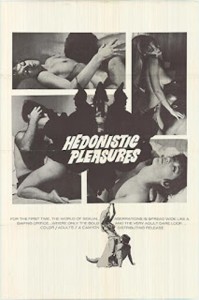 Oh, she was great. Yeah, she was amazing. She was a nice gal. I met her through Bob Cresse and Olympic International Films. He brought her out from New York. She acted in ‘Hedonistic Pleasures’ (1969) and ‘One Million AC/DC’ (1969), and she also worked behind the scenes on some films as well.
Oh, she was great. Yeah, she was amazing. She was a nice gal. I met her through Bob Cresse and Olympic International Films. He brought her out from New York. She acted in ‘Hedonistic Pleasures’ (1969) and ‘One Million AC/DC’ (1969), and she also worked behind the scenes on some films as well.
She was Don Jones’ girlfriend for a time. Later she got married to Dan Cady who made films under the name William Dancer.
I also did some loops on her. For some reason she didn’t like me. I think it’s because of those loops maybe. I don’t know, but she didn’t like me.
You also worked with Marsha Jordan.
Yeah, I used her in I think ‘Tropic of Scorpio’ (1968).
She was an old school soft-core actress, the last of the soft core era. She was the old guard. She was like a Kay Parker type in those days. Manny Conde filmed that. We filmed that out in some house in the Valley with a swimming pool.
What do you remember about Manny Conde?
He was one of the first guys that I worked for in Hollywood. I was his assistant cameraman on a Harry Novak feature right around the time that I worked on ‘She Freak’. I loaded the magazines and was his focus puller on some 35mm features he did for Harry Novak. I don’t remember the name of them.
Very nice guy. I liked Manny. He and I were friends all the way through. He was a real good guy.
A number of the films at this time were credited to Hayes Dupree. Who was that?
That was a pseudonym of mine; one of my many names.
You mentioned the Vista and the Paris theaters – which were part of the Continental feeder chain owned by Shan Sayles. Did you know Shan well?
I used to sell stuff to him but I didn’t really know him that well, I juts used to go and get money from him but I didn’t know him personally really.
Shan Sayles was notorious for having some shady business practices; how did you find him like a person to deal with from the standpoint of being a producer and rights holder?
I never dealt in the 35mm features with him. I just sold him loops and the 16mm stuff and he either paid me or didn’t, and if he didn’t pay me I didn’t give him the film. So I didn’t depend on him to do anything for me. If he wanted what I had, he paid me and I gave it to him.
So you shot loops at this time as well?
Yeah, I shot loops. They were called beaver movies, beaver films.
Where did you find most of the girls either for the beaver loops and the movies? Was it easy to find them or did you have an agency that you used?
This was the 1960s and there were hippie girls just swarming to Sunset Boulevard. They were barefooted and they smelled like patchouli oil and had love beads on, and they just loved to take their clothes off and make $25. They were just happy and they were all over the place.
When we started making these features, we had a couple of agents too. There was Hal Guthu and there was Bill Rotsler I think – maybe I got some girls from him too.
Do you remember what lab you were using at that time?
It was on La Brea, it was a lab out of Colorado. This guy, Jim Ganoo, opened up an office on La Brea just above Santa Monica. It was called Cinema something.
But there were a few labs, there was that one in La Brea and there was one on Western Avenue. Some guy from Canada had a small little lab, and then later we used a place that we used to do the newsreel footage right by the Paramount.
There were three or four labs, little labs. I don’t remember them getting busted but I guess they did. In those days I was just doing the beaver stuff so it didn’t really matter.
When you made films under this umbrella of Canyon Films, would you typically produce the press books yourself and do the marketing side?
Yeah. We had an artist that would come over and we’d talk about the press book and what we wanted. We had to make ad slicks for the theaters. We did little campaigns. This guy would come over, and we’d spend quite a lot on those ad campaigns. We spent about $1,500 on the 35mm features because we had to make the press book with the different size ads with those metal print block things. So we spent some good money on those.
You became close to Gary Graver (aka Robert McCallum) at this time?
Yeah, Gary and I were very good friends. I knew him well. I met him back when I was partners with Paul Hunt ever since we opened our first office. He came into our office down on La Brea, just came in the door. I don’t know how he heard about us but he just said he was a cameraman, and wanted work. He’d just got out of the army or navy, so we started using him. He was a great cameraman, a really good filmmaker.
The only gripe I ever had about Gary was that he would book himself double or three times. He would say, “Yeah, I’ll be there. I’ll do the movie”, but when you’d come to work the first day somebody else showed up, because he’d booked himself on another movie.
Was he easy to work with?
The guy worked day and night, he was completely tireless. He would start at 4:00am, be on the set at 5:00am, work all day, and that night he was going to edit a movie for somebody else all night long and then get up and do it again. He was unbelievable.
He made movies for me for Canyon Films, and then much later for me for Vista Video
I also remember he made some 35mm films independently that I distributed through my company.
Yeah, ‘The Hard Road’ and ‘Excited’ (1970).
Then there was also a bunch of 16mm features he did as well that I don’t remember the titles of.
One time we got sued by Erica Gavin. She sued me for $1 million I remember. It was just all a publicity thing to get her name in Variety.
That was for ‘Erika’s Hot Summer’ (1971)?
Yes – that was Gary directing. There were nude scenes which she said she didn’t signed up for. I didn’t even release that movie. Harry Novak did, so I didn’t care.
Gary then started working for Orson Welles in the early 1970s. What do you know about that?
He met Orson when Orson came into town once. He went and introduced himself and Orson snapped him up. Gary could do anything. Cameraman, set the lights, editing, everything, he was a dynamo.
In fact he shot ‘The Other Side of the Wind’ with Orson Welles, at my house; my A-frame house up on Cardwell Place.
Don Jones often worked with Gary Graver; did you work with him as well?
Yes, Don Jones an associate of Gary Graver’s, and he was a cameraman. He made a film for me too. He was a real good all around journeyman filmmaker.
Is he the same guy called D.E. Jones that made ‘The Kiss Off’ (1968)?
Yes – how did you know that?! ‘The Kiss Off’, and then we had one called ‘The Kill’ (1968). There were so many movies, I just don’t remember all the damn names. Maybe we had twelve 35mm features and about a hundred 16mm films that we put out.
Was there was a template for the films that were put out by Canyon? For example, was the funding done in the same way?
Not really. Some of them I bankrolled myself. Some of them I had partners. Some people made films and brought them to me. I would screen pictures and see if I would release them. I produced all of the 16mm features myself because they were cheap. The 35mm pictures, we typically made them for $10,000. Sometimes a little bit more, but that was basically what we spent on those pictures.
How about for the 16mm ones? Were they proportionately less?
Yeah, they were like $1,500.
I had all my own 16 mm equipment. All of the cameras and sound equipment and lights and everything. I would give that kit to the filmmaker and they’d go out. All they had to do was pay for the girls and shoot the stuff and they’d edit it in a couple of days.
You made money on all of them I guess, did you?
Yeah, I made good money.
How did the market change to hardcore?
The theaters just started asking for the hard stuff. I didn’t really want to make those hardcore movies. It was like they stopped playing the soft stuff. So I hired some people who would make some for me.
Who were the first people you hired to make the hardcore films?
That was that duo of Alain Patrick and Bob Chinn. I really dealt mainly with Alain, although I would also meet with Bobby. We were friends and I took them over to Hawaii once and we made a movie there, a little 16mm sex film. I can’t remember the name of it.
In his Rialto Report interview, Bob mentioned that he made a loop carrier with Hawaii called ‘Sexus in Paradise’ (1970).
That’s it! Yeah – we went over and shot some scenes in Hawaii because we wanted to go over there and have a little vacation, and he shot some other scenes over in California. Yes, that was it.
Bob said that he thought he started his association with you with a film called ‘Auto Eroticism and the Female’.
It could be. I don’t remember to tell you the truth.
An early film you made with Bob Chinn was ‘The History of Pornography’ (1970). How did that came about?
I think I was copying Alex de Renzy and his documentary ‘Pornography in Denmark: A New Approach’ (1970). I was always looking at Alex de Renzy as my hero because he made such good films. He was a couple of years older than I was and he had his own 35mm camera and he was a great filmmaker. He was real good and very successful. He was a very smart guy.
He was up in San Francisco and I was in Hollywood. I finally got to meet him and know him a little better when I partnered up with Mike Weldon years later when we had the Moving Picture Company and I moved up to San Francisco.
Anyway I think I had some magazines and some stuff that we used for the ‘The History of Pornography’ and I think I gave it to Bobby Chinn and we all pulled it together and made a little film out of it.
I remember ‘The Affairs of Aphrodite’ (1970) from that same time – Alain directed that too. He was a good director and a real good guy. They were both really good guys. They made a lot of movies for me.
You mentioned that you were reluctant to move away from the soft core but the theaters were demanding more and more hard core. Why were you resistant?
It was kinda gross. The early films, they were cute little films. They had nudity in them and simulated sex. It was easier to make those. They were more fun. The hardcore things, I don’t know. It just changed. It was a different atmosphere.
It was just a big shocking difference. I got used to it but I didn’t like it at first. In fact I didn’t shoot them at the beginning. I had other guys shoot them mostly.
Did you find that your attitude towards these films was universally held one among the other people who were making the nudie cutie stuff?
No, everybody jumped in and started making them. Gary Graver, he just jumped in with both feet and started making them and he filmed a lot of stuff I put out. He was my cameraman/ director on a lot of that stuff. He just made the transition with no problem. Maybe I was just a little embarrassed or something. I don’t know.
Did you have to be careful about what you could and couldn’t show? Were you ever busted for that?
The films I made… I wanted them to be right down the middle. I never wanted any kinky stuff or any people being hurt. I didn’t go to extremes.
Bobby Chinn later went to extremes in movies like ‘Little Orphan Dusty’ (1978). I didn’t want to produce films like that. I didn’t want to produce films where they were doing fisting and this and that. I was a distributor. I wanted to be right down the middle. I don’t want to be arrested. I always kept it in the middle.
One mystery film from your past is ‘Fusion’ (1970) – what do you remember about it?
Fusion was an R rated movie. It was shot during the transition period to hardcore, and I said, “Let me try to transition to an R-rated movie instead”, so I produced this movie.
We filmed it at my A-frame house in the Hollywood Hills and then around Hollywood. It was a murder thing. It was not a very good film but we did have some good camera work and it was photographed real nice.
I don’t remember if Alain Patrick was the director but Paul Hunt did some second unit photography and he’d built a little opening scene for that movie with Ron Garcia. I did a little intro, a little prologue, to it. It had Luanne Roberts and somebody, Michael Stern maybe. I forget the actors, but it wasn’t a success so I went back to the sex films.
Who were you distributing the films to?
The soft-core 35mm features I played in the Pussycat Theaters and other theaters throughout the United States, and I sold in Europe too.
I started making some 16mm hardcore for the Paris Theater in Hollywood and for those storefront theaters that sprung up. I used to ship these 16mm features to New York to Murray at the Avon in New York, and a few different theaters there in New York, and various other theaters throughout the country.
Would you get anyone else helping you get the films booked?
Yes, Harry Stern was huge for us. He was an old timer. I don’t know how old he was but I guess he was in his mid 60s. He had a satchel and he smoked a cigar. He would come in with all of his notes, and he knew all of the distributors and all of the film exhibitors that had theaters on Main Street all throughout America. He booked all my stuff just by calling the theaters up. They took everything Harry offered them, so he was a Godsend and he really put my company on the map. It was growing hog wild.
How long did that last?
It was great – until I was busted in 1972 for five counts of interstate transportation with a 5 year minimum and 25 year maximum, so I was looking at 125 years.
(Laughs) It said “The United States of America vs. Ed DePriest” and they made my name real small. When I got that subpoena or whatever the hell it was, it was something, let me tell you. This was in 1972 I believe, just before ‘Deep Throat’ (1972).
I fought it for a while and then I was convicted and had to go out of business for five years. That was the punishment: I couldn’t make any adult movies for five years. It was a pretty scary deal. I was pretty naïve.
Do you remember the films that were actually the ones that got you busted?
It was the 16mm stuff that Bobby Chinn and Alain were making for me. I got busted on all that 16mm crap. My 35 mm stuff wasn’t hardcore so that wasn’t a problem.
At this point, when you wound up Canyon Films in 1972, what did you do?
I went into partnership with Dave Arthur, who later became known as Kirdy Stevens, for a short while. He and I were partners. We had a company called Ad Pix. We did ‘Six Women’ (1971), we finished ‘Fusion’ (1970), and a few other pictures. Then we split up; I didn’t get along with him. We had real problems. We didn’t hit it off.
Can you remember the last film you made before you stopped production?
That was probably ‘Six Women’ (1971) which was with Ron Garcia. He’s become a very famous cameraman. Ron Garcia filmed it and Don Jones did the sound and Mike Bennett was the director and I was the producer on it. That was a 35mm feature. That was the last thing we did at Canyon Films, I think.
Ed DePriest – Hardcore in the 1970s:
After serving your time away from the adult film scene for a few years, you get back into film production in the mid 1970s – and re-connect with Mike Weldon.
After we parted ways back in 1968, he went to Tarrytown, New York and got married there.
He eventually came back to the west coast and started working for some independent theater company that had 30 or so movie theaters throughout California. He snowballed that into a film company where he bought a drive in theater, the Spartan Drive-In in San Jose. Then he bought the Jack London Cinema in Jack London Square in Oakland, and then he bought the Market Street Cinema and had the Larkin in San Francisco, so he did pretty well. By the time we got back in business together, he had a whole bunch of theaters.
Do you remember the film ‘Love Games’ (1976) which is credited to you?
Yes, I was living in Santa Monica at the time. Some stockbrokers put up some money, $15,000. We put that money in the film ‘Love Games’. I don’t even remember if we produced it or brought it or what. I didn’t make it, I know that much. Then I gave it to Manny for distribution so the stockbrokers would get their money back.
What is striking about that film is that it has a production date of 1975. The film is soft core, which was pretty much a dead market in the mid 1970s.
Yeah, maybe Manny was involved in making it. He was still doing soft-core stuff. Manny was very much against shooting hard core.
You then formed a company together with Mike?
Yes, around 1978 I partnered up with him to form the Moving Pictures Company in San Francisco. I moved to San Francisco.
We released films like ‘Teenage Cruisers’ (1977), then we made ‘Getting Off’ (1979) with Desiree Cousteau, and ‘Skintight’ (1981) with Annette Haven, and three or four other films.
How did you get involved with Johnny Legend and ‘Teenage Cruisers’ (1977)?
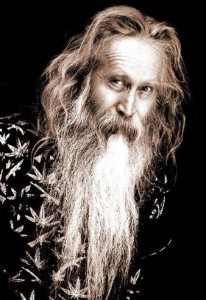 We didn’t make that film, we just released it. Johnny Legend made it. He was living in Venice, California and he made that in 35mm and brought it up and showed it to us. We thought it was awful long and that it really wouldn’t make any money. It was a cute film but we didn’t think it was geared for the adult film audience in terms of what they wanted. It was basically a rockabilly porn version of American Graffiti.
We didn’t make that film, we just released it. Johnny Legend made it. He was living in Venice, California and he made that in 35mm and brought it up and showed it to us. We thought it was awful long and that it really wouldn’t make any money. It was a cute film but we didn’t think it was geared for the adult film audience in terms of what they wanted. It was basically a rockabilly porn version of American Graffiti.
It’s a cute little film but it just wasn’t a sex film, although he did cut in some 16mm loops of John Holmes, Rick Cassidy and others. Anyway, we ended up putting it out despite our fears. It didn’t do great but it did make a little money.
What was Johnny Legend like?
He’s a great guy. I still know him, and we just did a show with him and Serena up in San Francisco a few months back; we showed ‘Teenage Cruisers’ and ‘One Million AC/DC’.
Do you still have rights on ‘Teenage Cruisers’?
We gave them back to Johnny. Twenty years later he wanted to know if we still had a copy. We had a couple of three quarter inch masters and I gave him those. He sells it on Amazon and eBay, and when he does public appearances.
What do you remember about ‘Getting Off’ (1979) which had Desiree Cousteau and John Leslie?
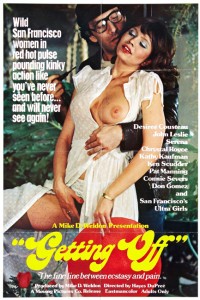 I had just shot some 16mm loops in San Francisco for Ultra Girls. I did about five or six loops with people like Connie Peterson and Serena. Mike says, “Why don’t we shoot something to tie it all together and make a feature out of it? Let’s get Desiree Cousteau and put her in it and we’ll make a little feature”.
I had just shot some 16mm loops in San Francisco for Ultra Girls. I did about five or six loops with people like Connie Peterson and Serena. Mike says, “Why don’t we shoot something to tie it all together and make a feature out of it? Let’s get Desiree Cousteau and put her in it and we’ll make a little feature”.
So we wrote a little wrap around thing to introduce Desiree and we shot some more stuff – I think two more days with Desiree, John Leslie and Pat Manning – and made it into a feature.
I used my ‘other’ name, Hayes Dupree, for this film, I think.
What was your experience like on the set?
Desiree was a nice gal and she was really easy to work with. She would do anything you wanted, but she seemed real vacant upstairs. She didn’t seem very smart but she was nice, very nice. Of course, she looked great.
John Leslie I like him. He was a good guy. I always had fun working with him.
It was a good crew; Don Jones was the cameraman, and he was the guy who got me started in the nudie film business back in the mid 1960s. Bill Marky did the sound. Bill became very successful – working on shows like ‘Hill Street Blues’ and winning Emmys.
Johnny Legend did some voiceovers for it as well with Pat Manning.
The film has had scenes involving a rose and urination that have been cut out over the years.
I wonder who cut that because when I put it out I didn’t cut it. Why would I?
The film has been issued on DVD through VCX.
VCX doesn’t have the rights to put that out. We sold Norm Arno non-exclusive rights for VHS only. They don’t have the rights for DVD.
What did you do to distribute the film?
In New York, I gave it to Mickey Zafferano and the Pussycat chain. In the Midwest, we had Arthur Weisberg, and then we handled the rest of the country ourselves.
Then you made ‘Skintight’ (1981) which has such a great cast with Paul Thomas, Annette Haven, and Lisa De Leeuw.
Yeah, that was the last film that I made in 35mm. It was good. I shot in 1980.
Mike Weldon produced it and we had a nice budget; he got ‘Dressed to Kill’ (1980), the De Palma film, for the Market Street Cinema in San Francisco on a first run basis and he made a lot of money from that. I think he had it for two weeks there, and we used the money off that to produce ‘Skintight’. We just had $25,000 right out of the cash register there on Market Street to fund ‘Skintight’.
We were paying everybody with cash each day, then we’d go back at night and get more money! There was just buckets of money at the cinema. That ‘Dressed to Kill’ film did really good.
How much did ‘Skintight’ cost to make?
I think we spend $75,000 on it. We spent a lot of money on it.
It was a big hit for us. It made good money. In fact I still sell it.
‘Skintight’ was a film that you actually used your real name on.
Yeah. I still regret that but Mike said, “Alex de Renzy puts his name on it. Why can’t you put your name on it?” So I did. I wish I didn’t, but I did. Anyway, the cat’s out of the bag now.
What was Alain Patrick’s role on the film?
Alain Patrick co-directed that with me. I think I wrote it with someone else but we did co-direct – and then he had a little argument. I’m sorry to say… but I think I was a little bit out of line. I think I wanted a little different direction with the film. I wanted to make it a little more edgy. I directed most of the scenes, like the rape scene, the fantasy scene. The stuff with Mai Lin and Annette Haven, I let Alain direct. I just thought it was a little pedestrian and I wanted to bump it up a little bit, make it a little more interesting.
When I would go to shoot a movie I had a lot of pressure on me to keep everything going. I was wearing different hats, a producer, a director and this and that. Sometimes I got a little cranky. I guess I was over-concerned about trying to keep my thing going and I don’t think it was a friendly set.
That must have been Alain’s last involvement in adult film.
I didn’t follow what he did afterwards. We split up. Shame because I liked him. He was a nice guy. I probably treated him badly.
Do you have any memories of directing any of the performers?
We filmed up there in Mill Valley in a nice location.
I had a good experience shooting the fantasy sequence with Lisa De Leeuw in the middle of the film. The scene didn’t have anything to do with the film but we wanted to put something neat in there. Lisa was terrific.
What do you remember about the music?
That was Paul Sabu, he was one of those heavy rock musicians. He was Sabu’s son, the ‘Elephant Boy’.
Which labs would you use towards the end of the 1970s for developing these films?
For ‘Skintight’ we used Patterson Labs in San Francisco. There was a 35mm lab on Potrero. It’s not there anymore. I think Alex de Renzy did a few of his films there.
Was this the last film that you were involved with that was shot on film?
Yeah, it was.
A director who you worked with frequently was Charles Webb aka Charles DeSantos.
Yeah, I did a lot with Charles Webb. Charles Webb and I made quite a lot of films together. I met him at Mike Weldon’s office in San Francisco. Mike and I released his early stuff like ‘China De Sade’ (1977) on video. We had a film with… what was that girl with the big tits on North Beach? Carol Doda.
You mean ‘Honky Tonk Nights’ (1978)?
Yes – that’s the one!
Ed DePriest – The Video Years:
How did you move into video?
Mike and I took the 35mm films we had and we made conversions to three quarter inch tape. We were selling the nonexclusive rights to these titles to Norm Arno at VCX and some other companies. We knew they were making a lot of money.
Mike just wanted to sell the rights, which I was dead against. I was somebody who never wanted to sell rights. I want to keep them forever.
Mike and I disagreed so we split up. He had his theaters. All I had was the movies but he didn’t care that much about them. He just wanted to make a quick buck and he was going to sell four or five video companies the same movie, everybody nonexclusive, we get $1,500 and they had the damn movie.
So you formed another company by yourself?
I went down to LA and reorganized myself and started Vista Video in 1982 or 1983. I did a movie on video called ‘Young and Restless’ with Kimberly Carson. I directed that and my friend Mike Striker photographed it.
How did you sell it?
I went over to Norm Arno at VCX and said I want to show you the movie I got.
They said, “Where did it play?” I said, “It’s not 35mm it’s a video tape.” They said “No, we don’t want to see a video tape.”
But when they looked at it, they thought it was great. It was a big hit for me. I sold over 10,000 units. It was a real big hit. I had opened Pandora’s Box. Everybody saw that I had made a movie for just $10,000 instead of $50,000. The floodgates were opened.
All the companies were buying from me for $25 bucks a pop. I don’t know if you guys remember but the VHS tape cost $10 a blank tape at the beginning. We’d buy a box of a 100 VHS tapes of $1,000.
Norm at VCX would sell them for $50 bucks a piece for the Betacam and VHS markets. That didn’t last long. For the first year it was very expensive and the prices were very high. But we didn’t mind paying $10 from when we sold the damn thing for $50.
What were your memories of Norm Arno?
My relationship with him was good because he always gave me money. Distributors made money with Norm and I was a distributor.
I could go over there and get $4,000 or $5,000. He’d buy 300 pieces from me at a time and he always paid me. I made a lot of money with Norm. Some people didn’t like him and said he was a thief. If he was making money with you then things were okay. If you just had one film and you went over there you’d probably get screwed over but if you had a continual line of product coming through there he’d have to keep paying you because he’d be making money. If he didn’t pay, you just cut his nose off.
Were there any people that you specifically were wary of because they had bad reputations in terms of distribution?
To be honest, I had problems with Mike Weldon my partner. He was my friendly enemy. I made money with the guy but I never got a fair shake with him. The business is all about power, who’s got the upper hand? It’s like if you’ve got a lot of product then they’ve got to pay. If you’ve only got one film, you’re finished. It’s probably that way in any business.
What was the best thing about video vs. film?
I saw that it as a way of making money. If you’re dealing with 35mm theatrical releases, it takes a long time to make a movie and it takes a long time to get some money back. It’s a year and a half to two years before you get any real money back. In the video, three months later you can be in hog heaven. You can be making money. I had rent to pay.
Were you satisfied with the look of video?
I really liked it. It wasn’t like film but you’ve got to remember in 1981, everybody thought that video was great. It was a different medium with a different format. I jumped in and I liked it. It was easy to do, it was cheap and you could experiment.
So you started out by shooting videos yourself?
Yes – I made three of them, ‘Sensuous Moments’ (1983), ‘Young and Restless’ (1983), and ‘Sleepless Nights’ (1985). They were all profitable.
The last movie I ever made was in 1984, it was ‘Sleepless Nights’.
Thereafter I either bought or had people make them for me. Gary Graver made some for me, Charles Webb made some for me, and there were two or three other guys that made films for me.
So you stayed friends with Gary Graver who was now prolific in the X-rated industry?
He did a lot of stuff for me for Vista Video. Then, when I moved to San Francisco, I talked to him a few times and kind of lost touch with him. One day Sage Stallone called me and told me that Gary was selling his equipment. I said, “What do you mean?” and he told me that Gary was dying. I said “Oh my God…” so I got his number and I called him up. I got his answering machine but I think he was already in the hospice when I called. He just got cancer and died shortly afterwards.
I couldn’t believe it. He never smoked. He would maybe have a little glass of wine at the end of the day. He didn’t use drugs. A little acid in the early days but he was a real clean guy. He didn’t abuse himself like Paul Hunt did.
It was a sad thing, he was a great guy, we had a lot of fun together. I went to his memorial.
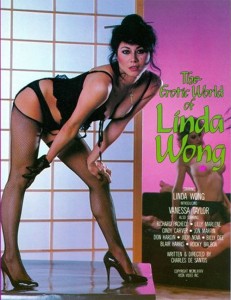 Charles Webb made ‘The Erotic World of Linda Wong’ (1985) for you; how did this come about?
Charles Webb made ‘The Erotic World of Linda Wong’ (1985) for you; how did this come about?
Charles says, “I’ve got this girl. I used her in ‘China De Sade’. She’s really great”. I said, “Okay. Come up with a story, and make a film.” His films are basically all the same but with different people. So I gave him $15,000 and he made it.
And for a time you lived with Linda Wong.
(Laughs) Yes – this was after that film. You know what they say, “that which does not kill you only makes you stronger” but she definitely tried to kill me.
She was heavily into drugs, wasn’t she?
Ah yes… Jesus Christ. A lot of my friends were drinkers and smokers and druggies, and now they’re dead. Maybe that’s why everybody thought I was dead.
You’d split up with her by the time she died of a drug overdose?
Yeah, thank god. Charlie Webb called me and told me she’d died, and the first thing I thought was, “Whew, Jesus, she could’ve died right there in my bed”.
She was out of control. Boy, she was beautiful and she was really… as beautiful and great as she was, the other side of her was the worst thing in the world. She was a complete disaster.
When I look back on those days, I must’ve been completely insane but I was a victim of an enchantment.
Did you date any other people from the industry or was that …
Nah, just the beginning of my career and the end of my career, those were the bookends.
How did Vista Video come to an end?
It was a nice little run there on Vista Video. I’m not that good of a businessman but I was doing $80,000 a month that was coming in the door.
Then I moved away from Los Angeles. I had some personal problems and I got tired of the smog. I basically folded the company up and moved back to San Francisco and started Mirage Video. With Mike Weldon again.
I partnered with Mike for a while for about four, five years in San Francisco then unfortunately Mike passed away. He had a heart attack. He wasn’t even 50, he was about 47. I think he died in 1990.
When he died he was a millionaire, but he died early unfortunately.
What did you do then?
I moved down to Morro Bay, went into the post-production business in the early ‘90s through 2005. For about 15 years I was buying and gathering content but I also bought some Betacam SP equipment and I was editing in Betacam and doing Betacam transfers. In the ‘90s people were shooting in Betacam. I put a lab together and I had some contacts from Hollywood and I would do people’s lab work. I was doing over a $100 grand a year doing post-production. It was a nice run for me.
The lab was Ed DePriest Productions, and during that time I did some more movies.
What pseudonyms did you use at this point in your career when you made films?
Mainly ‘Jules Martin’ and a few others. The thing is to keep the wolf from the door, because he was always across the street kind of looking at me, lurking in the ivy, and to keep him at bay I had to make a lot of movies, and in the 1990s I would make these video features. I was mass-producing this stuff. You may have not heard of me then but I was very active.
Then you formed Golden Age Media?
Golden Age Media is about five years old. It’s basically content and a website, movie streaming, and DVD sales. I do mail order company and stuff like that.
I bought out 200 titles from Bob Genova and then he died like a year later. I got titles from Mike Esposito. I got titles from Nitro. I just picked up piles of this content when companies would fold. I’ve got like 300 – 400 titles but a lot of them are in three quarter inch.
What are you doing now?
I am excited about a couple of things that I’m doing now relating to the golden age adult cinema. I have my websites Porn Classics, and Titillation TV which is going to be streamed in Roku. I’ve got five channels that are going to be on this Titillation TV. I am throwing my hat in the ring all over again. I’ve got 400 movies that I own and I’m streaming them so you’ll be able to look at them from your PlayStation or Roku or your handheld device.
You can visit Ed DePriest’s websites here:
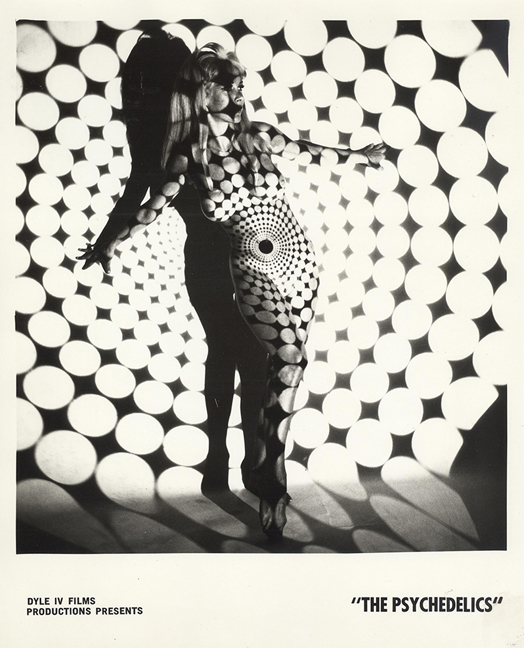
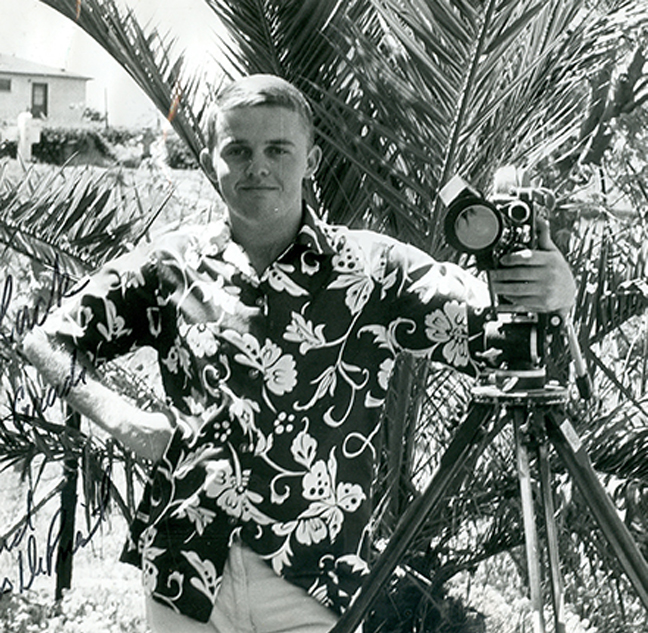
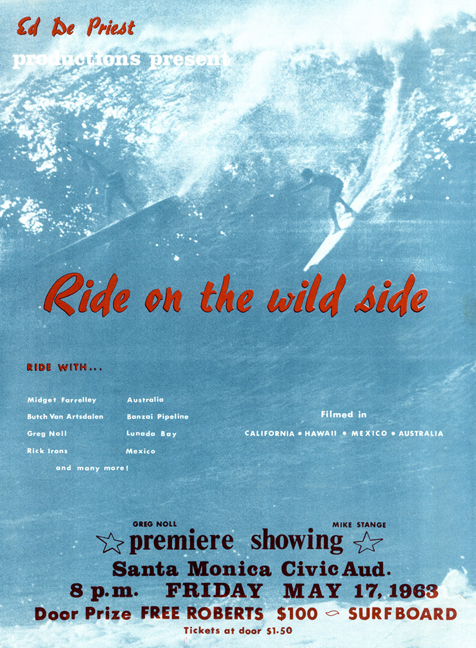
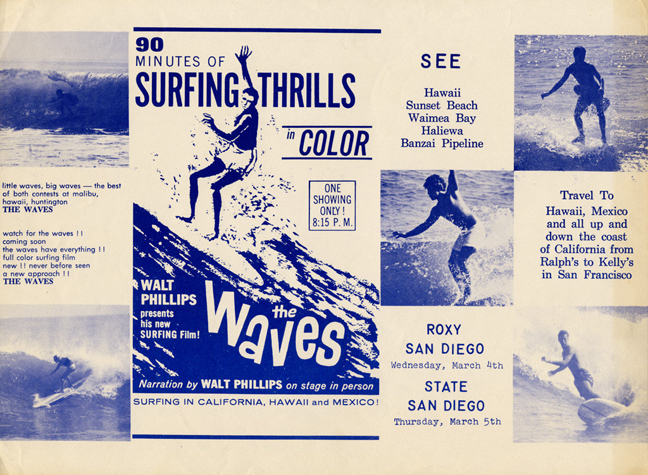
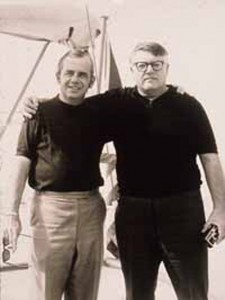
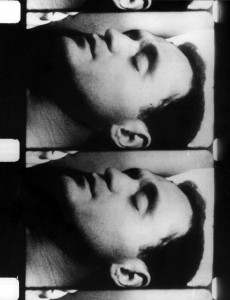
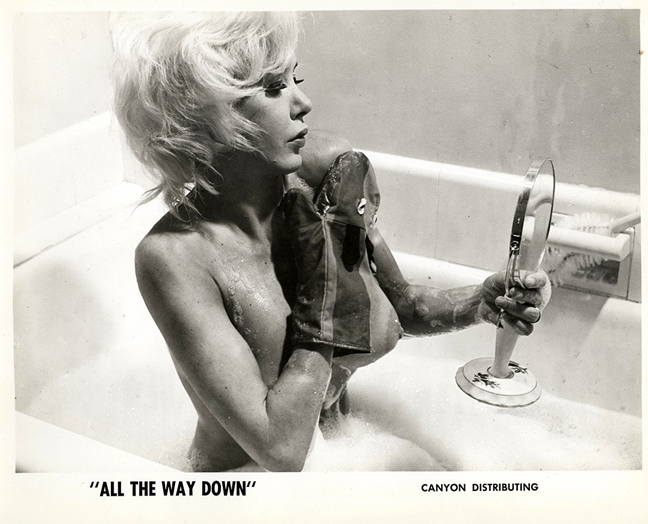
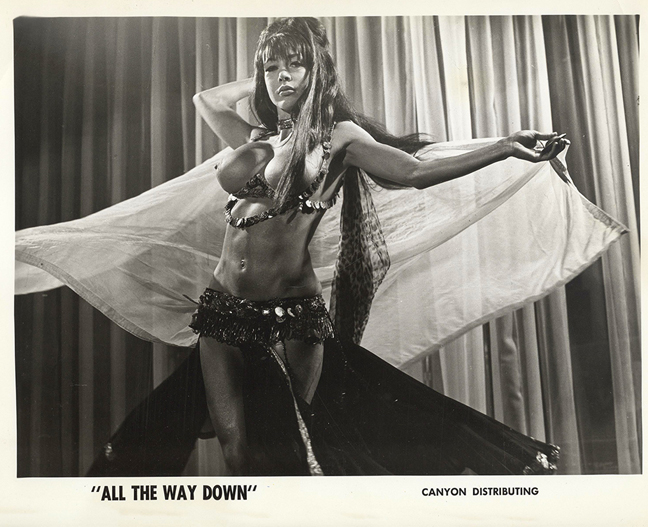
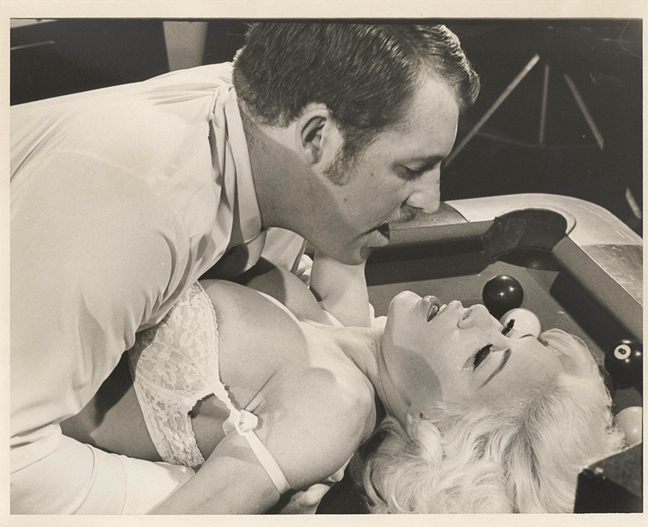
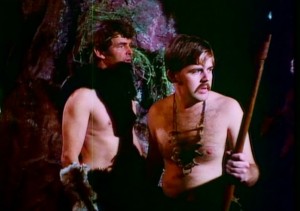
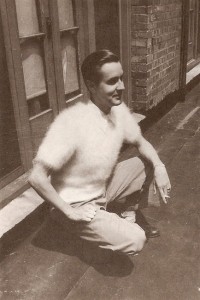
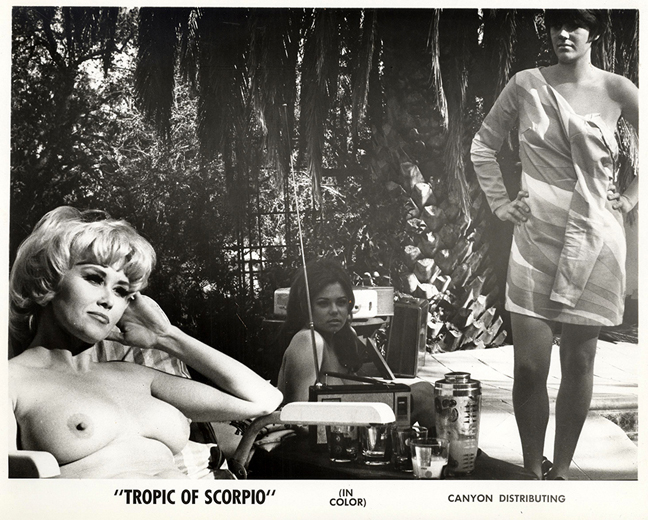
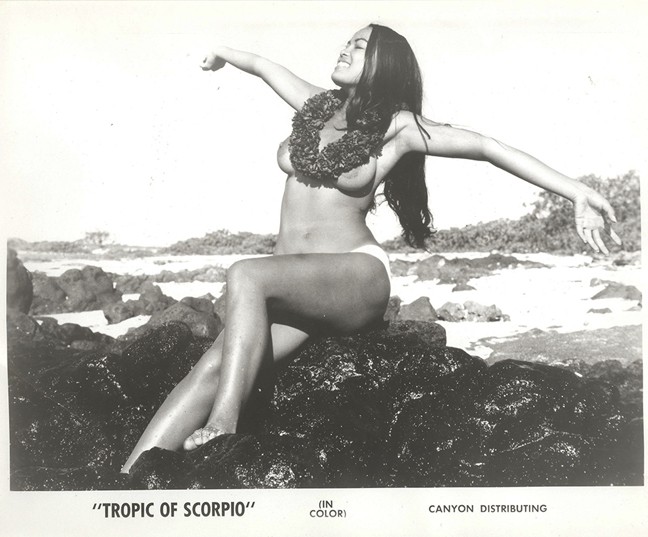
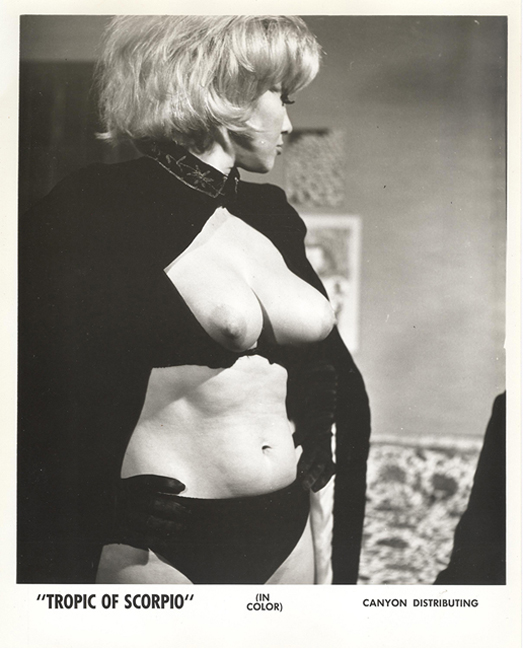
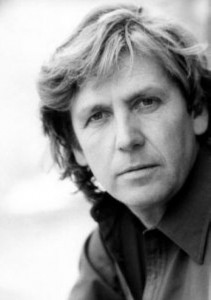
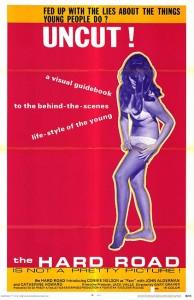
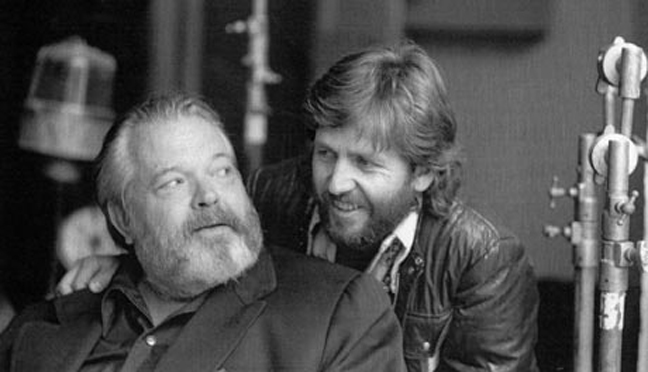
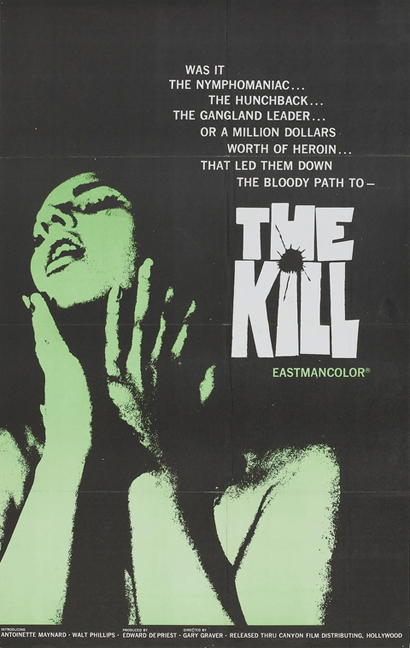
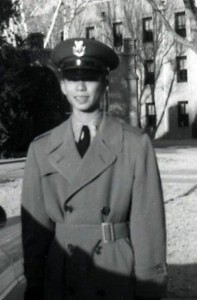
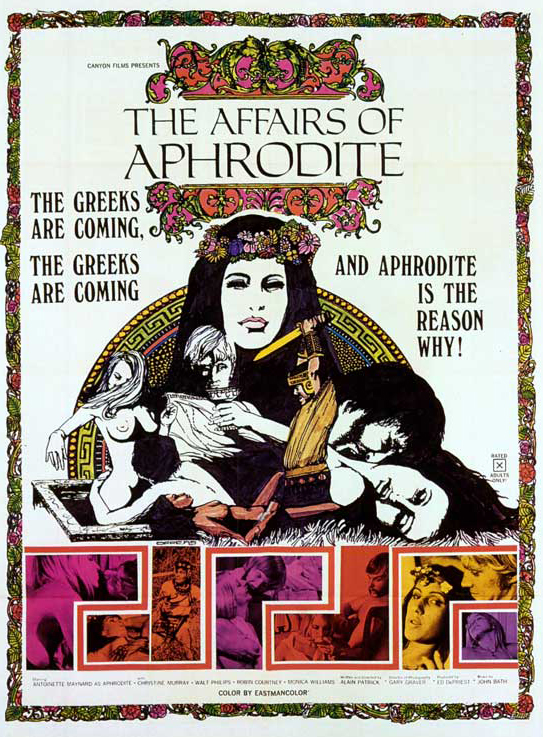
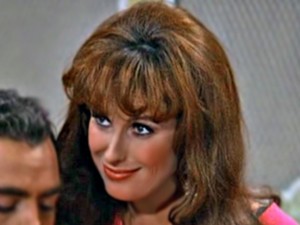
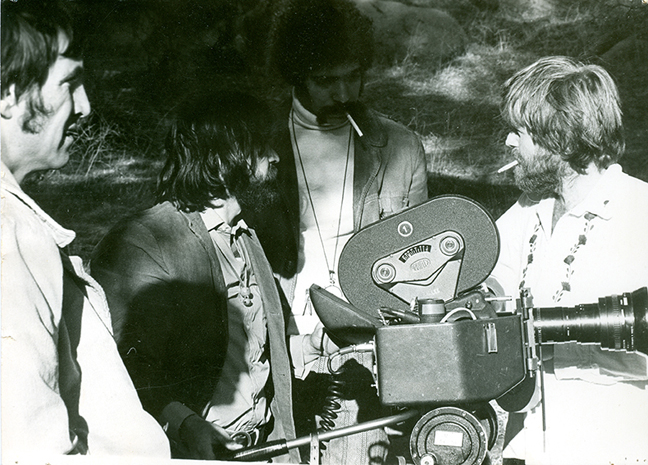
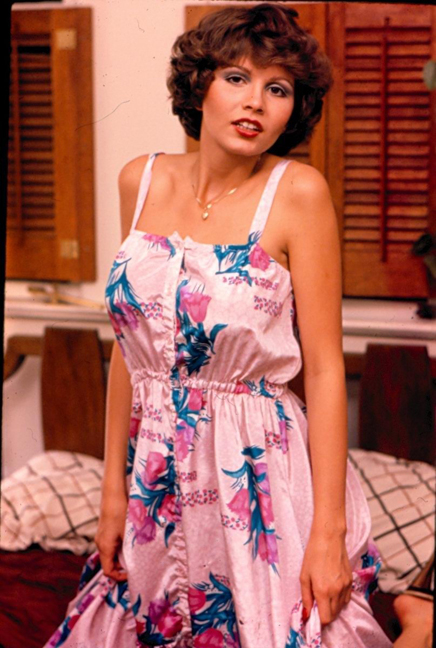
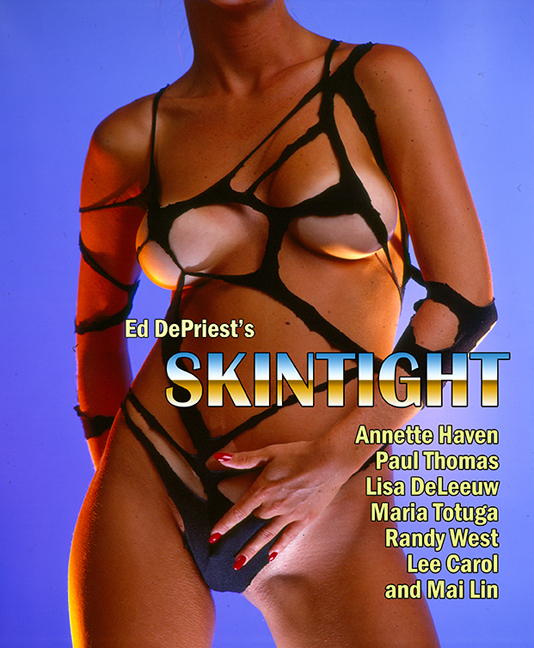
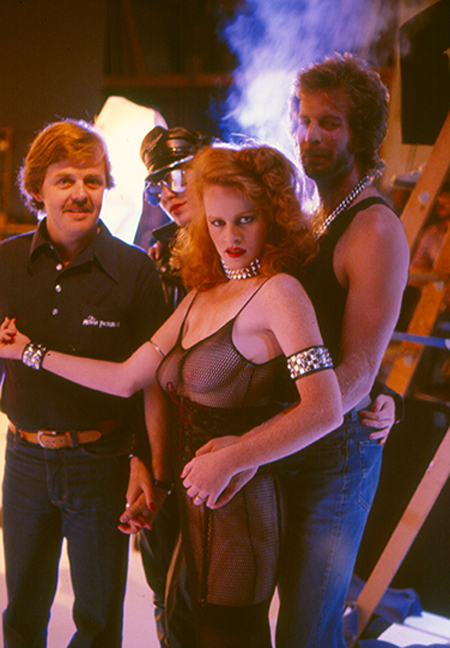
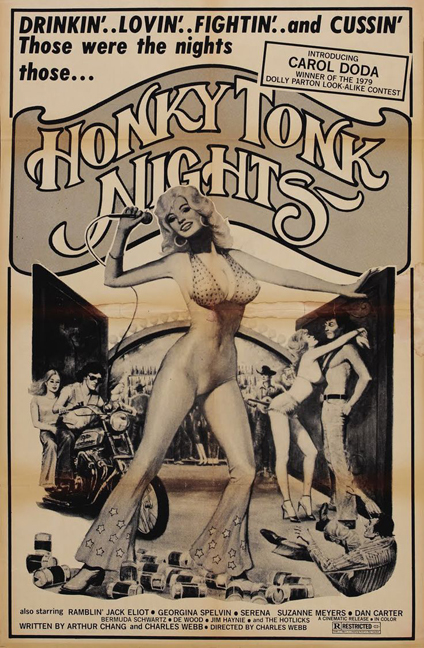
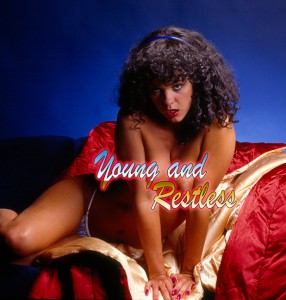
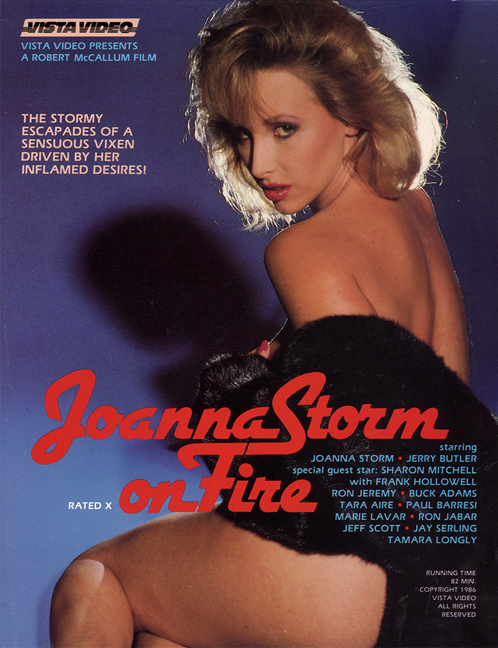
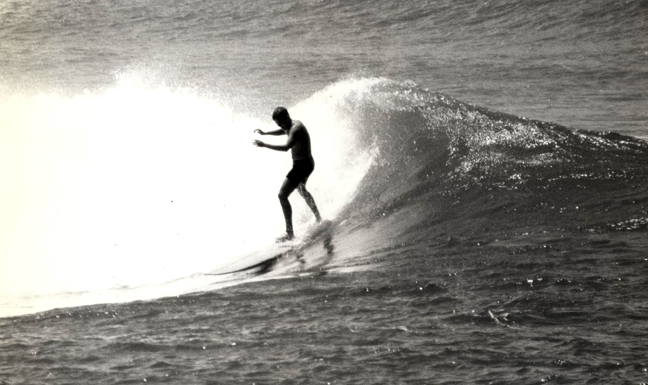
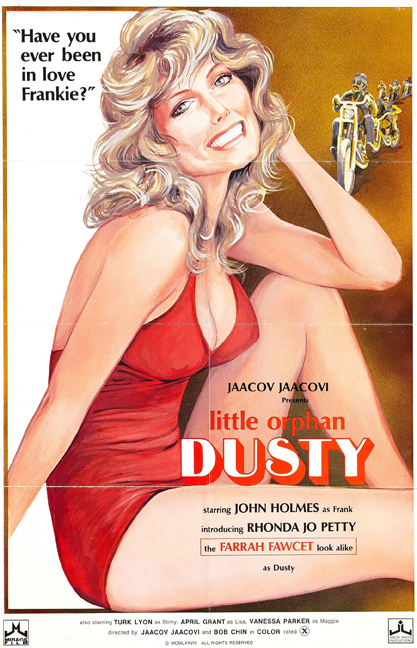

I’ve been looking for more information on this cat for many a long year.
Much obliged for the great interview.
And he’s still selling and distributing films in 2014..?! Not bad for a guy who started in 1962.. I’d heard he’d died too, so it’s good to see him alive and kicking.
Very interesting and informative article on Ed DePriest,for it was surprising seeing a lot of familiar genre names attached to this piece(including the son of Sabu[of THE JUNGLE BOOK]),as well as a lot of knowledgable things about the film business(both mainstream and adult/porn).
amazing — a slice of the entire history of sex movies !! great work, guys — and Ed DePriest has a GOOD memory !!!
A simply marvellous interview – fascinating and informative. Great to hear Mr DePriest talk about his colleagues, especially the much-missed Gary Graver. Now if only FUSION would turn up… Many thanks to all involved.
The Rialto Report’s interviews set a high watermark, and this was no exception. Amazing guest, good questions, interesting stills. How about a show or feature about Gary Graver? I’d love to know more about him. Hearing Kay Parker’s comments about him on the recent podcast was great!
Memory lane throughout this entry.
DePriest; I hear his name, remember his face and I just smile.
Wow, such an in depth interview on a prolific enduring persona. This site will be encyclopedic before you know it.
Just before he tragically passed away at the end of 2013, I had the great privilege of listening to a considerable portion of the interview that the formidable Tony Biner/TobyDammit did with Mr. DePriest. Perhaps The Rialto Report could entice Biner’s estate to donate that material to its archives so that we could hear the impressive fellow’s words come alive. Hearing him would most certainly provide another dimension of insight as well as information since simple prose only scrapes the surface of the soul.
I rather like the printed interviews. It gives subjects more time and space to reply to questions with more in depth answers. And so I like these ones just as much as the audio. In what is a visual medium, there is always a literary flavor missing that leaves less room for raconteur intellectuals more witty with written words than verbal spoken.
I am writing a definitive article about Antoinette Maynard. Any chance her name came up in this interview? Any chance Antoinette was mentioned. Any chance I can get ahold of Ed to ask questions about her? Another great interview. Thanks!
I worked and partied with Ed in ’69 -’71. I shot stills for a couple of his films. Like most from that era I went on to do other things, but as I get older, I think about some of the more interesting of life’s experiences. I’d love to see you again.
Cheers
Alan
I worked for Ed DePriest and Mike Weldon distributing their films through my company, National Pictures Company in Hollywood. Ed was great to work with; Mike, not so much. Ed’s History of Pornography made buckets of money on Its release. Mike tried to back Ed into a corner with an exclusive release deal that would have screwed Ed. My company distributed the film on a 5th run and made a disgusting amount of money.
Just like reliving the past 50 years. Reviving a lot of suff for my up coming book… Hollywood ???
Jacques “Jack” Descent
wow all that I never knew its amazing I always thought ed de priest was amazing
I was Mike Weldon’s GM at Moving Pictures 1977-1982, and worked with Ed dePriest on Skintight; I was “the” non technical crew: rented the 35mm projector; bought the 35mm film; rented the lenses; brought the actressrs to the set, etc—Ed was a real pro and an easy going guy to work with and for; Weldon was always uptight and a skinflint and power hungry—hope Ed is still breathing